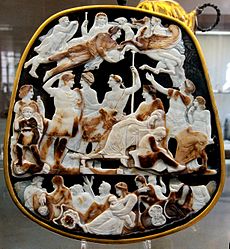Kameo (ukiran)
Tampilan

Kameo (/ˈkæmioʊ/) adalah sebuah metode mengukir sebuah objek seperti ukiran permata, bahan perhiasan atau vessel. Metode tersebut biasanya dipakai pada gambar relief
Daftar pustaka
[sunting | sunting sumber]- Jarrett, Diana (2009). Cameos Old and New- 4th Edition. ISBN 978-0-943763-60-6.
- Miller, Anne (2003). Cameos Old and New. ISBN 0-442-00278-5.
- Draper, James (2009). Cameo Appearances: Metropolitan Museum of Modern Art. ISBN 978-0-300-14145-0.
- Dunlop, Paul H., The Jokelson Collection of Cameo Incrustation, ISBN 0-9619547-3-6
- Scarisbrick, Dianna (2003). Classical Gems: Ancient and Modern Intaglios and Cameos in the Fitzwilliam Museum, Cambridge. ISBN 978-0-521-23901-1.
- Henig, Martin (1990). The Content Family Collection of Ancient Cameos-Ashmolean Museum. ISBN 978-1-85444-004-4.
- Fiorelli, Anna (1989). Corals and Cameos – The treasures of Torre Del Greco.
- Walters, H.B (1927). Catalogue of the Engraved Gems and Cameos, Greek, Etruscan, and Roman in the British Museum.
- Neverov, O (1971). Antique Cameos in the Hermitage Collection. Aurora Art Publishers.
Pranala luar
[sunting | sunting sumber]Wikimedia Commons memiliki media mengenai Cameos.
